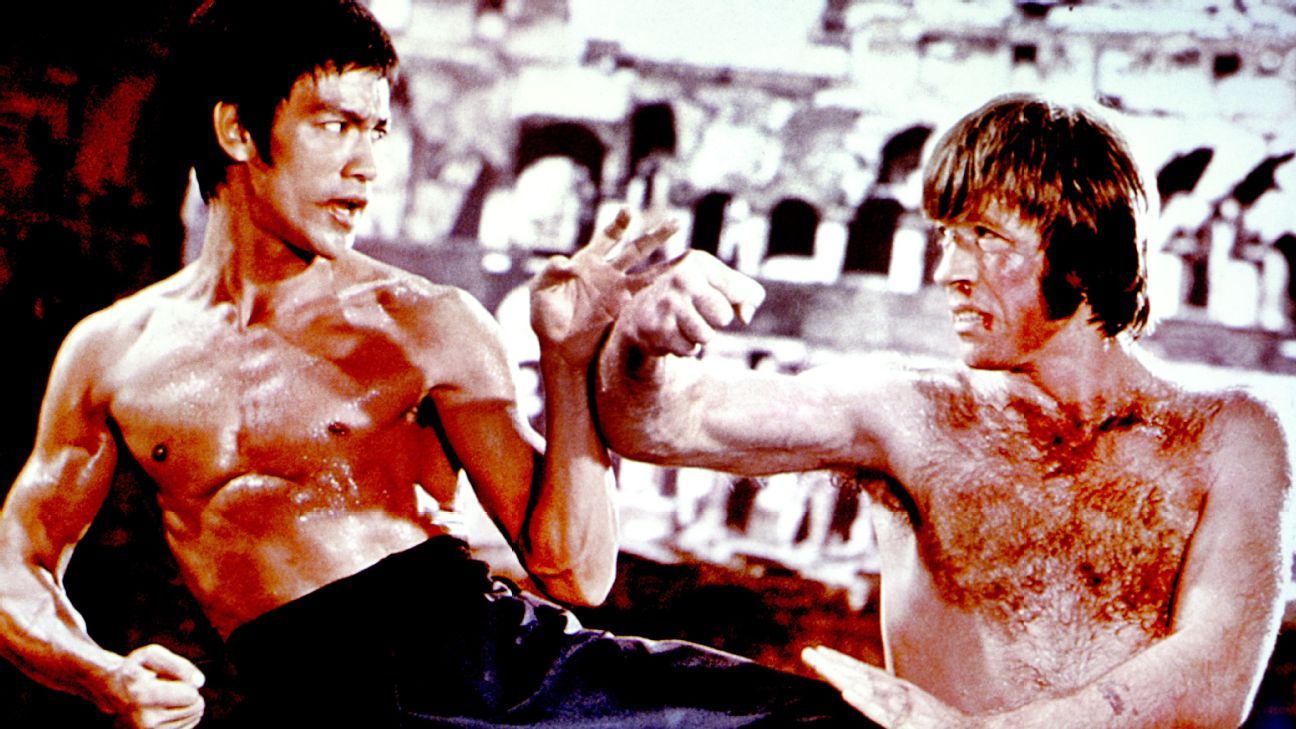
And perhaps no question about Lee is as trivial yet ardently pursued as this: Could Bruce Lee win a real fight.
It's in some ways predictable that fans hungrily debate the skills of the man who refined and mainstreamed the martial arts film as we know it.
Last summer, Quentin Tarantino, in his revisionist odyssey "Once Upon a Time in Hollywood," added his impudent voice to the debate when he depicted Lee, played by actor and martial artist Mike Moh, as a vainglorious braggart who gets into a fight with Brad Pitt's Cliff Booth, a stuntman and former Green Beret.
"He was continuously marginalized and treated like kind of a nuisance of a human being by white Hollywood," she said, "which is how he's treated in the film.".
He would later use submission holds to finish opponents in his fight scenes, like his classic guillotine choke of Chuck Norris in "The Way of the Dragon." In addition to LeBell, Lee worked for years with the likes of Norris and Joe Lewis, two of the most celebrated non-boxing fighters of their day.
"You can't tell me that Bruce Lee is not a hard guy, wasn't a good martial artist, wasn't a good fighter, if you got guys like Joe telling me that," Thompson says.
Lewis, who died in 2012, said it was under Lee's tutelage that he broke with karate point fighting once and for all and transitioned into full-contact fighting.
The fact that fighters like Lewis trained with Lee before he was Bruce Lee -- learned from and taught him, and took him seriously -- provides a great deal of evidence as to what kind of fighter Lee might have been.
The equivalent today of what Lee was doing back then, working with real fighters as a peer, would be like watching actor Jason Statham sparring in earnest with UFC light heavyweight champ Jon Jones; it would never happen.
"That's what a true martial artist can do -- they can adapt under any circumstance," McGregor said.
"Bruce Lee said, 'Be like water.' When water enters a cup, it becomes the cup.".
And Manny Pacquiao, asked by The New York Times to describe his fighting style, said simply, "Like Bruce Lee.".
It was Lee's first encounter with Western boxing and his first time competing in a rules-based tournament instead of street fighting.
The fight planted the first seed of doubt about the effectiveness of Wing Chun's orthodoxy in Lee's mind and left him with a lifelong aversion to tournament fighting and an obsession with the problems of fixed styles.
Years later, after he moved to Seattle and began training others in martial arts, Lee would often boast that his Wing Chun was the preeminent fighting style, leading to frequent arguments and challenges from adepts of other forms.
One such argument resulted in the second-most storied fight of Lee's career, a showdown with Yoichi Nakachi, a Japanese karate black belt.
A similar incident led to the most important fight of Lee's career, in Oakland in 1964.
After weeks of negotiating the time and place and rules, Wong and a handful of friends drove to Lee's training and teaching studio in Oakland.
A composite of all the various accounts, eyewitness testimony, hearsay and urban legend thrice removed, transmuted by time and distorted by Lee's staggering posthumous celebrity, amounts to something like the following: Wong Jack Man extended a hand in what he said was a preliminary greeting (think touching gloves before a boxing match), Lee dispensed with that pleasantry and rushed forward, sending his opponent back.
His new ideas about martial arts -- that it had to be syncretic, streamlined, bespoke, honed for combat instead of aesthetics, paved the way for mixed martial arts, an embryonic form of which he practiced when he developed his own personal form, Jeet Kune Do.
"HE WAS YEARS ahead of his time," says Dan Inosanto, a disciple, training partner and close friend of Lee's who still teaches Jeet Kune Do.
Inosanto believes Lee's training methods helped mainstream the adoption of focus gloves, now used throughout the fighting world to sharpen accuracy and timing.
(One dabbles in BJJ the way one dabbles in poetry: You hope no one ever asks to see the proof.) He draws a hard line between martial arts and fighting.
No, I would need years and years of specific training just to fight.".
Since the UFC debuted in 1993, mixed martial arts have undergone a dramatic evolution.
The development of MMA around the world forced a lot of martial arts theorizing and teaching to melt in the flash fire of real fighting.
It's almost impossible to succeed as a professional mixed martial artist without at least a solid BJJ foundation.
The true fighting abilities of Lee's martial artist-actor successors like Seagal and Van Damme and Jackie Chan are questioned all the time, typically with a sense of humor (save for the subjects of the query).
Martial arts is quasi-religious, and when you're insulting Bruce Lee, it's like insulting someone's iconic saint hero, almost a religious figure.".
The main account of Lee's fight against Noichi Yakachi comes from Jesse Glover's book "Bruce Lee: Between Wing Chun and Jeet Kune Do." Glover, who died in 2012, was Lee's first student and later a highly respected martial artist.
While he has the utmost respect for Lee as a martial artist, he believes that the only thing that makes one a fighter is fighting other professionals, and often.
DESPITE THE BRUISED sensibilities of Lee's fans around the world, Bruce Lee doesn't actually lose his fight in "Once Upon a Time in Hollywood." Tarantino stops several seconds short of the heedless revisionism he flaunts in the rest of his film.
Its faithfulness to what a fight between two such men might feel like is exactly what the real Bruce Lee strove to achieve in his own work
